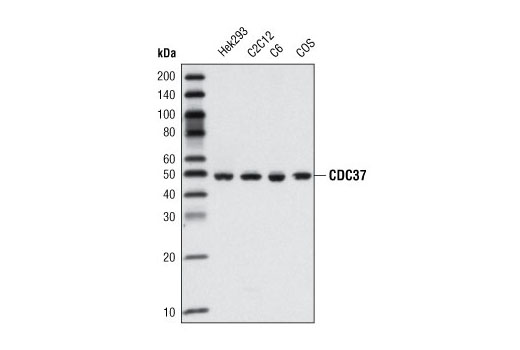WB
H M R Mk
Endogenous
50
Rabbit
#Q16543
11140
Product Information
Product Usage Information
| Application | Dilution |
|---|---|
| Western Blotting | 1:1000 |
Storage
Specificity / Sensitivity
Species Reactivity:
Human, Mouse, Rat, Monkey
Source / Purification
Polyclonal antibodies are produced by immunizing animals with a synthetic peptide corresponding to residues surrounding Val367 of human CDC37. Antibodies are purified by protein A and peptide affinity chromatography.
Background
CDC37 is an important component of the HSP90 chaperone complex (1,2). It was initially identified for its involvement in cell-cycle progression and was later found to have a much broader role as a chaperone for a wide variety of kinases and other proteins (1-3). CDC37 protein has an amino-terminal kinase binding domain followed by a central HSP90 binding domain. It recruits and stabilizes kinases in the HSP90 complex by protecting the newly synthesized kinase peptide chain from degradation and promoting the next step of protein maturation (4,5). CDC37 also suppresses the ATPase activity of HSP90, thereby leading to conformational changes in the complex that preclude target kinase loading (6). CDC37 has been proposed as a therapeutic target because of its important role in multiple kinase pathways involved in proliferation and cancer cell survival, including Raf, Akt, Src, and ErbB2 pathways (7,8).
- Karnitz, L.M. and Felts, S.J. (2007) Sci STKE 2007, pe22.
- Caplan, A.J. et al. (2007) Trends Cell Biol 17, 87-92.
- Caplan, A.J. et al. (2007) Cell Cycle 6, 3145-7.
- Mandal, A.K. et al. (2007) J Cell Biol 176, 319-28.
- Lee, P. et al. (2002) J Cell Biol 159, 1051-9.
- Siligardi, G. et al. (2002) J Biol Chem 277, 20151-9.
- Kimura, Y. et al. (1997) Genes Dev 11, 1775-85.
- Gray, P.J. et al. (2008) Nat Rev Cancer 8, 491-5.
Species Reactivity
Species reactivity is determined by testing in at least one approved application (e.g., western blot).
Western Blot Buffer
IMPORTANT: For western blots, incubate membrane with diluted primary antibody in 5% w/v BSA, 1X TBS, 0.1% Tween® 20 at 4°C with gentle shaking, overnight.
Applications Key
WB: Western Blotting
Cross-Reactivity Key
H: human M: mouse R: rat Hm: hamster Mk: monkey Vir: virus Mi: mink C: chicken Dm: D. melanogaster X: Xenopus Z: zebrafish B: bovine Dg: dog Pg: pig Sc: S. cerevisiae Ce: C. elegans Hr: horse GP: Guinea Pig Rab: rabbit All: all species expected
Trademarks and Patents
Limited Uses
Except as otherwise expressly agreed in a writing signed by a legally authorized representative of CST, the following terms apply to Products provided by CST, its affiliates or its distributors. Any Customer's terms and conditions that are in addition to, or different from, those contained herein, unless separately accepted in writing by a legally authorized representative of CST, are rejected and are of no force or effect.
Products are labeled with For Research Use Only or a similar labeling statement and have not been approved, cleared, or licensed by the FDA or other regulatory foreign or domestic entity, for any purpose. Customer shall not use any Product for any diagnostic or therapeutic purpose, or otherwise in any manner that conflicts with its labeling statement. Products sold or licensed by CST are provided for Customer as the end-user and solely for research and development uses. Any use of Product for diagnostic, prophylactic or therapeutic purposes, or any purchase of Product for resale (alone or as a component) or other commercial purpose, requires a separate license from CST. Customer shall (a) not sell, license, loan, donate or otherwise transfer or make available any Product to any third party, whether alone or in combination with other materials, or use the Products to manufacture any commercial products, (b) not copy, modify, reverse engineer, decompile, disassemble or otherwise attempt to discover the underlying structure or technology of the Products, or use the Products for the purpose of developing any products or services that would compete with CST products or services, (c) not alter or remove from the Products any trademarks, trade names, logos, patent or copyright notices or markings, (d) use the Products solely in accordance with CST Product Terms of Sale and any applicable documentation, and (e) comply with any license, terms of service or similar agreement with respect to any third party products or services used by Customer in connection with the Products.
